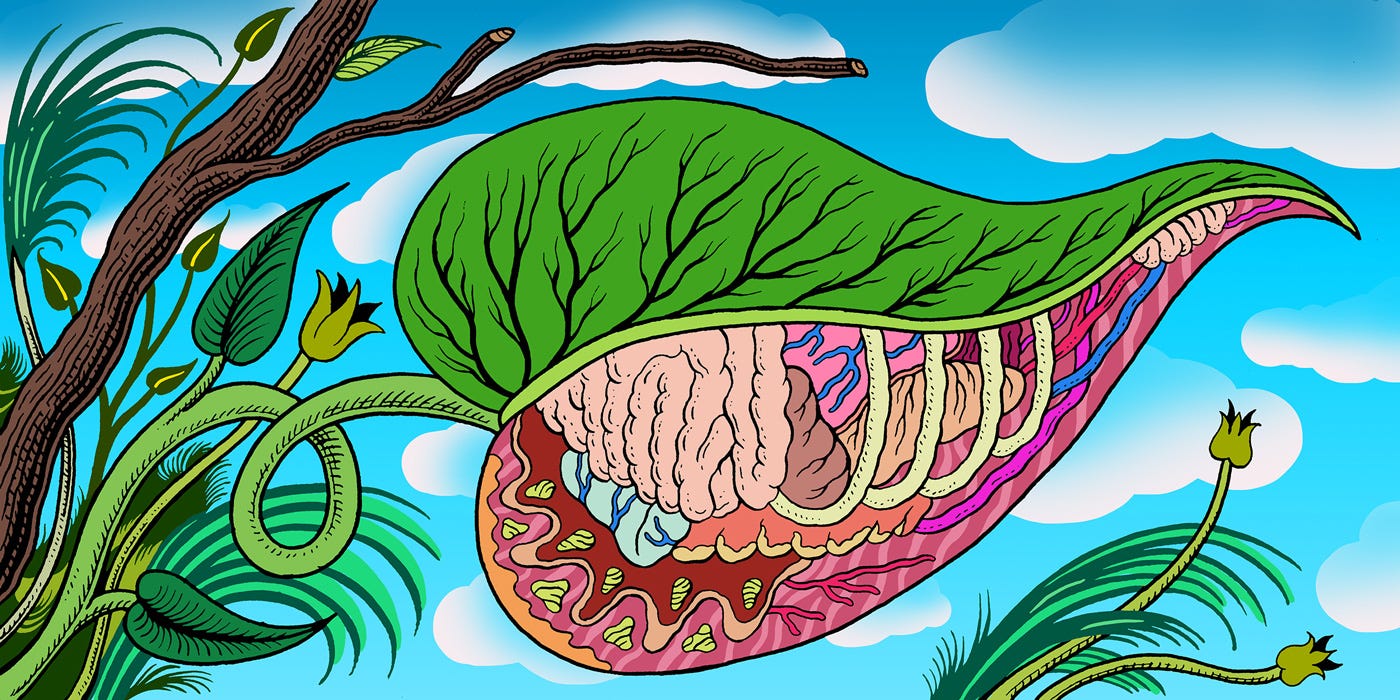The Beef Is of the Grow


Meat Doesn't Grow on Trees—But Perhaps It Could
What if your steak came from the greenhouse instead of the slaughterhouse?
T o make meat out of brute cells but no actual animals, yous accept to solve a big (meaty!) problem: Where practise you grow the stuff?
Though it might audio similar a vegetarian's nightmare, the answer could be to produce the meat on plants.
Glenn Gaudette is seeing if he can make that happen. A professor of biomedical engineering at Worcester Polytechnic Plant in Massachusetts, Gaudette is growing cow muscle cells on spinach leaves.
It's early on days — Gaudette told NEO.LIFE at the New Harvest conference at MIT concluding Friday that he will have data in a couple of weeks. But experts in the field of lab-grown meat (also known every bit "cultured meat" or "make clean meat") say that Gaudette could exist addressing i of the technology's large problems. Plant leaves could give cultured meat a scaffold that also happens to exist edible.
Brian Spears, CEO of the startup New Historic period Meats in San Francisco, heard the idea for the first time in Gaudette'south presentation at New Harvest. "That was really exciting," he says. "We're going to try that."
Growing meat without using the body of an animal might be more environmentally sustainable. But the meat cells need to multiply on a structure that supplies them with nutrients, as blood vessels practice in an brute.
Joshua Gershlak, a graduate educatee working with Gaudette, pointed out that plants feed their cells with blood-vessel-like structures with the same branching patterns seen in animal tissue. So they used detergents to strip the found cells away from spinach leaves, a process called decellularization. What's left backside looks like a spinach leaf, but it's stake white and has a texture like Styrofoam. Concluding yr they coaxed human stem cells to grow into beating middle tissue on this spinach skeleton—work that might have implications for tissue regeneration technologies. Now they are trying to get cow stalk cells to develop into the muscle cells that make up a tasty steak or hamburger.
Various other materials be for growing cultured meat. Some that piece of work well as scaffolds, including materials known as hydrogels, are non necessarily edible, meaning some other step volition be needed to remove the meat. As for the edible options, at that place are silk, chitosan (from shrimp and other crustaceans), zein (from corn), and alginate (from seaweed). "Simply whether cells grow well on them is another affair," says Marianne Ellis, of the University of Bath, a biochemist and tissue engineer who is collaborating with Gaudette.

Even though growing meat on leaves could be inexpensive and clean, in that location are big obstacles. The most central is that no i knows how well animate being stalk cells grow on establish skeletons, because no i has tried it. "Stem cells are notoriously finicky," says Spears. To grow into the kind of cells that make upwards a sausage or steak, the cells need to non just grow and thrive, only they must besides differentiate properly into skeletal muscle cells, and not veer off into another kind of jail cell or revert to stem cells.
Stephanie Wallis, chief scientific officer of College Steaks, a cultured meat company in London, says she believes cultured muscle cells won't grow properly if the scaffold doesn't take the exact right shape or provide the proper distance between cells. Stem cells likewise densely packed will dice, go unhealthy, or differentiate into the wrong kind of cell.
Plant leaves have a structure that tin't exist manipulated and customized as easily every bit other scaffolding materials, says Wallis. But in that location's a chance that'southward OK: plants come in a wide variety of shapes and sizes, and maybe ane of those is already perfect for growing cultured meat. Gaudette and Gershlak accept decellularized not only spinach just also other kinds of leaves, including parsely.
To abound meat this mode, researchers volition demand to ensure that the detergents used to strip the plant cells away don't exit any residuum that's either harmful or bad-tasting.
Ellis says she and her students tin't yet examination whether plant-based scaffolds impact the taste of cultured meat, either for better or worse. Considering food isn't allowed in nearly scientific labs, she says, "they're not allowed to consume the research yet."
Source: https://medium.com/neodotlife/meat-on-a-leaf-glenn-gaudette-9b2765a861f0
0 Response to "The Beef Is of the Grow"
Post a Comment